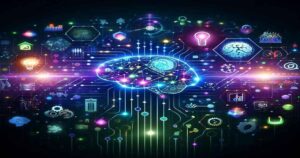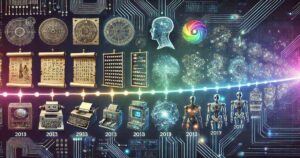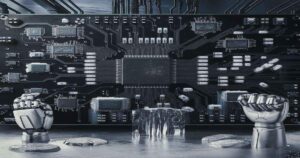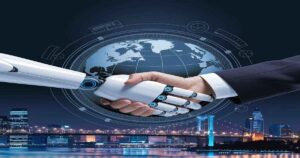The evolution of Artificial Intelligence (AI) is a remarkable journey through decades of innovation, trial, and triumph. From philosophical concepts to transformative real-world applications, AI’s history encapsulates humanity’s relentless quest to build intelligent machines. This blog post takes a step-by-step look into the origins, milestones, challenges, and future of AI, ensuring readers gain a deep understanding of this fascinating field.
Understanding Artificial Intelligence

Before delving into history, let’s define artificial intelligence. AI refers to the simulation of human intelligence by machines programmed to perform tasks such as reasoning, learning, and problem-solving. These capabilities allow AI systems to adapt and improve over time.
Types of AI

1. Narrow AI: Designed for specific tasks like voice recognition or image analysis.Discover the latest tools for writing essays with AI, a prominent application of Narrow AI.
2. General AI: A theoretical form of AI capable of performing any intellectual task a human can do.
3. Superintelligent AI: An advanced AI surpassing human intelligence (currently hypothetical).
Origins of Artificial Intelligence
The roots of AI extend far back, predating the invention of computers.Explore a detailed account of AI’s historical journey on Britannica.
Philosophical Beginnings

In ancient times, philosophers such as Aristotle proposed logical frameworks to understand reasoning. His ideas about syllogism laid the foundation for structured thought processes in AI.
In the 17th century, thinkers like René Descartes and Leibniz theorized about mechanical reasoning and universal problem-solving, concepts that would later inspire AI systems.
The First Machines of Logic
In the 19th century, Charles Babbage and Ada Lovelace designed the Analytical Engine, a precursor to modern computers. Lovelace’s notes on the machine hinted at its potential for more than arithmetic, an early nod to AI’s broader applications.
The Birth of Modern AI (1950s)
The mid-20th century marked the formal beginning of AI as a scientific discipline.
Alan Turing and the Turing Test

In 1950, Alan Turing proposed the “Turing Test,” a way to evaluate a machine’s ability to exhibit intelligent behavior indistinguishable from a human. This became a benchmark for AI development.
Dartmouth Conference (1956)
The term “Artificial Intelligence” was coined at this historic event, organized by John McCarthy, Marvin Minsky, and others. It marked the beginning of AI as an academic field.
Early AI Programs
1. Logic Theorist: Created by Newell and Simon, it solved mathematical theorems using logic.
2. General Problem Solver (GPS): An ambitious attempt to build a machine that could solve any problem humans could articulate.
The AI Boom and Winter (1960s-1970s)

The 1960s saw an explosion of optimism in AI, but limitations soon led to setbacks.
Expert Systems and Their Success
Expert systems like MYCIN and DENDRAL used rule-based logic to solve specific problems in medicine and chemistry. They demonstrated AI’s potential in specialized domains.
Challenges and the AI Winter
Overpromises and underwhelming results led to reduced funding and interest in AI research, a period known as the AI Winter. Limited computational power and insufficient data were major barriers.
Resurgence of AI (1980s-1990s)
With advancements in technology, AI regained momentum.
Revival of Neural Networks
The development of backpropagation algorithms allowed AI systems to learn from data.Learn how Machine Learning models are managed efficiently using advanced algorithms.reviving interest in neural networks.
AI in Robotics
Robots like Shakey the Robot demonstrated the integration of AI in physical systems. NASA used AI in autonomous systems for space exploration.
AI Meets Big Data
As data storage and processing capabilities grew, AI began leveraging vast datasets for improved learning and decision-making.
AI Revolution in the 21st Century

The 21st century ushered in a golden age of AI, driven by big data, advanced algorithms, and powerful hardware.
The Rise of Deep Learning
Deep learning, a subset of AI, transformed fields like natural language processing and computer vision.Understand how convolutional neural networks power cutting-edge deep learning systems. Companies like Google and OpenAI developed cutting-edge systems capable of complex tasks, such as AlphaGo defeating human champions in Go.
Everyday Applications of AI
Healthcare: AI is used for diagnostics, drug discovery, and personalized medicine.
Transportation: Autonomous vehicles are a reality, with companies like Tesla leading the charge.Explore Elon Musk’s vision for robotics and AI in the future of technology.
Finance: AI powers fraud detection, credit scoring, and algorithmic trading.Dive deeper into the transformative use of AI in banking and finance.
Ethical Challenges in AI
As AI advances, it brings complex ethical dilemmas.
Bias in Algorithms
AI systems often inherit biases from their training data, leading to unfair outcomes.
Privacy Concerns
The widespread use of AI raises concerns about data security and user privacy.
Regulation and Control
Governments and organizations are grappling with creating guidelines for responsible AI use.
The Future of Artificial Intelligence
AI’s potential is limitless, but its trajectory depends on how we address its challenges.
General AI Development
Researchers are working towards General AI, systems capable of human-like reasoning across all domains.
Collaborative Intelligence
Future AI systems are likely to enhance human abilities, fostering collaboration between humans and machines.
Solving Global Issues
AI is poised to address challenges like climate change, global health crises, and sustainable development.
Conclusion
The history of artificial intelligence is a testament to human innovation and ambition. From ancient philosophical musings to transformative technologies, AI has redefined what machines can achieve. As we look to the future, the responsible and ethical development of AI will determine its role in shaping our world.
AI’s journey is far from over. With every breakthrough, it continues to blur the line between science fiction and reality, offering endless possibilities for humanity.


